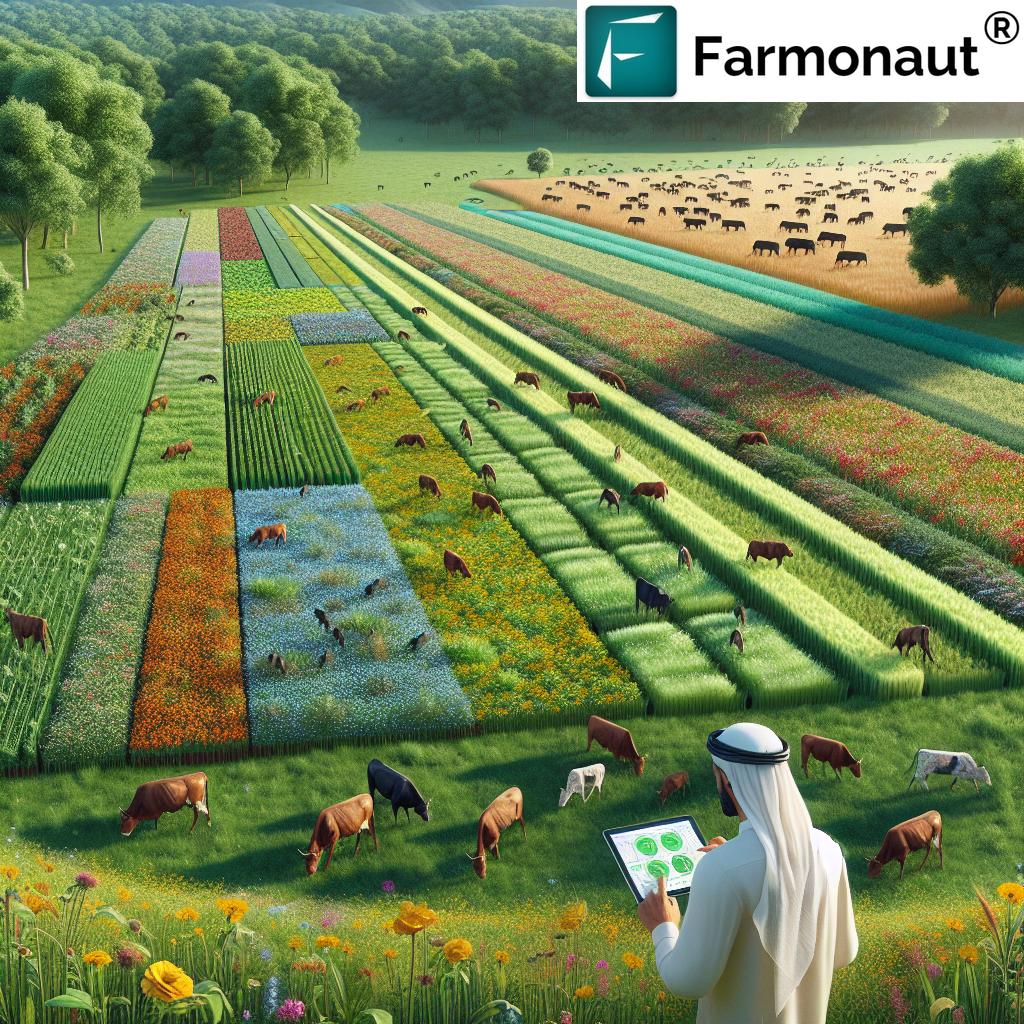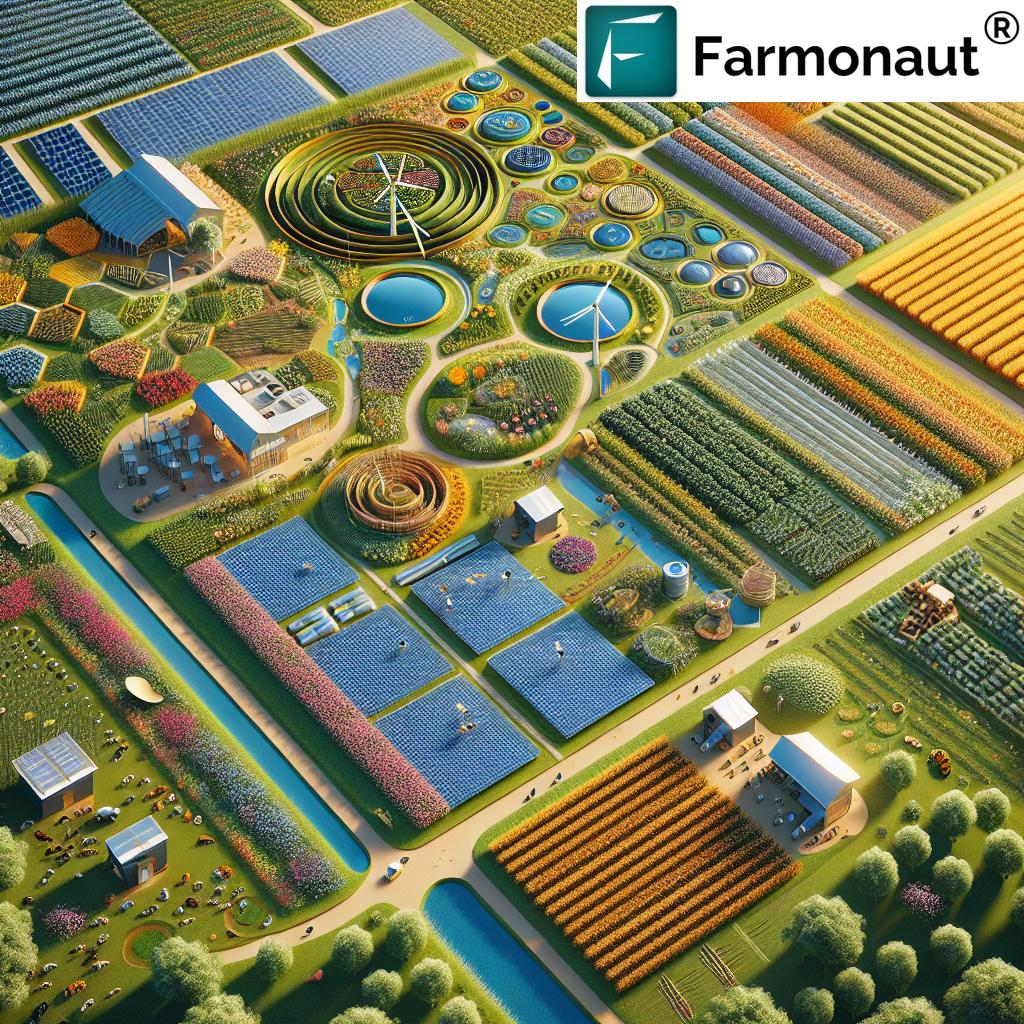EU Biodiversity Strategy Mid-Term Review: Farmonaut’s Guide to Sustainable Agriculture and Precision Farming Solutions
“The EU Biodiversity Strategy aims to protect 30% of land and sea areas by 2030, a significant increase from current levels.”
As we delve into the crucial topic of sustainable agriculture and biodiversity protection in farming, we find ourselves at a critical juncture in the fight against environmental degradation. The mid-term review of the EU Biodiversity Strategy offers us a timely opportunity to assess our progress and chart a course for a more sustainable future. In this comprehensive guide, we’ll explore the findings of this review, highlighting both the advancements made and the challenges that lie ahead in preserving agricultural biodiversity.
At Farmonaut, we recognize the vital role that agritech solutions play in supporting conservation efforts and enhancing biodiversity while maintaining productive farms. Our innovative approach to precision farming techniques aligns perfectly with the goals outlined in the EU Biodiversity Strategy, and we’re committed to providing farmers with the tools they need to embrace more sustainable practices.

The State of Biodiversity in European Agriculture
The mid-term review of the EU Biodiversity Strategy paints a complex picture of the current state of biodiversity in European agriculture. While there have been some notable advancements in species and habitat protection, the overall trend of biodiversity loss continues at an alarming rate. This situation underscores the urgent need for increased efforts in integrating environmental policy across various sectors of agriculture, including arable land management and rural development.
Key findings from the review include:
- Progress in designating protected areas, with many EU countries on track to meet the 30% target by 2030
- Improvements in the conservation status of some species, particularly those covered by the Birds and Habitats Directives
- Continued decline in farmland birds and pollinators, indicating ongoing challenges in agricultural landscapes
- Insufficient progress in restoring degraded ecosystems, particularly in intensively farmed areas
These findings highlight the need for a more holistic approach to biodiversity conservation that encompasses not only protected areas but also the wider agricultural landscape. This is where precision farming techniques and sustainable agriculture practices become crucial.
The Role of Precision Farming in Enhancing Biodiversity
Precision farming techniques offer a promising avenue for enhancing biodiversity while maintaining productive farms. By leveraging advanced technologies such as satellite imaging, AI, and IoT sensors, farmers can optimize their resource use, reduce chemical inputs, and create more favorable conditions for wildlife.
At Farmonaut, we’re at the forefront of this technological revolution in agriculture. Our satellite-based crop health monitoring system allows farmers to:
- Identify areas of stress in crops before they become visible to the naked eye
- Apply inputs such as water and fertilizers more precisely, reducing runoff and environmental impact
- Create targeted conservation areas within fields based on productivity data
- Monitor the health of natural habitats adjacent to farmland
These capabilities not only improve farm productivity but also contribute to the creation of a more diverse and resilient agricultural ecosystem.
Integrating Environmental Policy in Agriculture
The mid-term review emphasizes the importance of integrating environmental policy across various sectors of agriculture. This integration is crucial for achieving the goals of the EU Biodiversity Strategy and ensuring that agricultural practices support rather than hinder biodiversity conservation.
Key areas of focus include:
- Promoting sustainable land management practices that enhance soil health and biodiversity
- Encouraging crop diversification and the use of traditional varieties to increase genetic diversity
- Supporting the adoption of agroecological practices that work with natural processes
- Developing policies that reward farmers for ecosystem services and biodiversity conservation
Farmonaut’s technology plays a crucial role in supporting these efforts by providing farmers with the data and insights they need to make informed decisions about land management and conservation.
Ecosystem Restoration Techniques in Agriculture
Ecosystem restoration is a critical component of the EU Biodiversity Strategy, with ambitious targets set for restoring degraded ecosystems by 2030. In the context of agriculture, this involves a range of techniques aimed at rebuilding soil health, restoring natural habitats, and creating corridors for wildlife.
Some key ecosystem restoration techniques relevant to agriculture include:
- Reintroduction of hedgerows and field margins to provide habitat for wildlife
- Creation of wetlands and ponds to support aquatic biodiversity
- Establishment of wildflower meadows to benefit pollinators
- Agroforestry practices that integrate trees into agricultural landscapes
Farmonaut’s satellite imagery and AI-powered analytics can help farmers identify the most suitable areas for these restoration efforts, ensuring that they complement rather than conflict with productive farming activities.

The Impact of Technology on Sustainable Farming
Technology is playing an increasingly important role in driving sustainable farming practices and supporting biodiversity conservation efforts. From precision agriculture tools to blockchain-based traceability systems, these innovations are helping farmers reduce their environmental impact while improving productivity.
At Farmonaut, we’re leveraging a range of cutting-edge technologies to support sustainable agriculture:
- Satellite-based crop monitoring for optimized resource use
- AI-powered advisory systems for personalized farm management
- Blockchain technology for supply chain transparency and traceability
- IoT sensors for real-time monitoring of soil and environmental conditions
These technologies not only help farmers improve their operations but also provide valuable data for policymakers and researchers working on biodiversity conservation.
Challenges and Opportunities in Agricultural Biodiversity Preservation
While the mid-term review of the EU Biodiversity Strategy highlights some progress, it also underscores significant challenges in preserving agricultural biodiversity. These challenges include:
- Balancing food production demands with biodiversity conservation
- Addressing the impacts of climate change on agricultural ecosystems
- Overcoming resistance to change among some farmers and stakeholders
- Securing adequate funding for biodiversity conservation initiatives
However, these challenges also present opportunities for innovation and collaboration. By embracing sustainable agriculture practices and leveraging technologies like those offered by Farmonaut, farmers can play a crucial role in reversing biodiversity loss while maintaining productive and profitable operations.
“Despite conservation efforts, global biodiversity is declining at rates 100 to 1000 times higher than the natural extinction rate.”
Farmonaut’s Contribution to Sustainable Agriculture and Biodiversity Conservation
At Farmonaut, we’re committed to supporting farmers in their transition to more sustainable and biodiversity-friendly practices. Our suite of tools and services is designed to make precision agriculture accessible and affordable for farmers of all sizes.
Key features of our platform include:
- Real-time crop health monitoring using satellite imagery
- AI-powered advisory systems for optimized farm management
- Blockchain-based traceability solutions for supply chain transparency
- Carbon footprint tracking to support sustainability initiatives
By providing farmers with these powerful tools, we’re helping to bridge the gap between agricultural productivity and biodiversity conservation.
Experience the power of Farmonaut’s precision farming solutions:
Integrate our API into your agricultural solutions: Farmonaut API
Access our comprehensive developer documentation: API Developer Docs
The Way Forward: Recommendations for Enhancing Biodiversity in Agriculture
Based on the findings of the EU Biodiversity Strategy mid-term review and our experience at Farmonaut, we propose the following recommendations for enhancing biodiversity in agriculture:
- Increase adoption of precision farming techniques to optimize resource use and reduce environmental impact
- Promote the integration of natural habitats within agricultural landscapes
- Develop policies that incentivize farmers to adopt biodiversity-friendly practices
- Invest in research and innovation to develop new sustainable farming technologies
- Enhance education and training programs for farmers on biodiversity conservation
- Strengthen collaboration between farmers, researchers, and policymakers
- Increase public awareness about the importance of agricultural biodiversity
By implementing these recommendations and leveraging innovative technologies like those offered by Farmonaut, we can work towards a future where agriculture and biodiversity thrive together.
EU Biodiversity Strategy Progress and Challenges
| Aspect | Progress | Challenges |
|---|---|---|
| Species Protection | Improved status for some species covered by EU directives | Continued decline in farmland birds and pollinators |
| Habitat Conservation | Progress towards 30% protected area target | Slow restoration of degraded ecosystems |
| Sustainable Farming Practices | Increased adoption of organic farming (8.1% of EU agricultural land) | Limited uptake of agroecological practices in conventional farming |
| Precision Agriculture Adoption | Growing use of precision farming technologies | Uneven adoption across regions and farm sizes |
| Funding Allocation | Increased EU funding for biodiversity (7.5% of EU budget) | Insufficient private sector investment in biodiversity conservation |
| Stakeholder Engagement | Improved collaboration between farmers and conservationists | Resistance to change among some agricultural stakeholders |
Conclusion: A Call to Action for Sustainable Agriculture
The mid-term review of the EU Biodiversity Strategy serves as both a reality check and a call to action for all stakeholders in the agricultural sector. While progress has been made in some areas, the overall trend of biodiversity loss remains a grave concern. It’s clear that we need to accelerate our efforts and embrace innovative solutions to achieve the strategy’s ambitious goals.
At Farmonaut, we’re committed to being part of the solution. Our advanced agritech solutions provide farmers with the tools they need to adopt more sustainable practices, optimize their operations, and contribute to biodiversity conservation. By leveraging satellite technology, AI, and blockchain, we’re helping to bridge the gap between productive agriculture and environmental stewardship.
However, technology alone is not enough. Achieving the objectives of the EU Biodiversity Strategy will require increased funding, stronger stakeholder engagement, and greater public awareness. It’s crucial that we work together – farmers, policymakers, researchers, and technology providers – to foster a healthier relationship between agriculture and nature.
As we move forward, let’s embrace the opportunities presented by sustainable agriculture and precision farming. By doing so, we can create a future where farms are not just productive, but also serve as havens for biodiversity, contributing to the health and resilience of our ecosystems for generations to come.
Join us in revolutionizing agriculture for a sustainable future:
Frequently Asked Questions
- What is the EU Biodiversity Strategy?
The EU Biodiversity Strategy is a comprehensive plan aimed at protecting and restoring nature in the European Union by 2030. It sets ambitious targets for biodiversity conservation, including protecting 30% of land and sea areas. - How does precision farming contribute to biodiversity conservation?
Precision farming uses technology to optimize resource use, reducing the environmental impact of agriculture. This can lead to less chemical use, better water management, and the creation of spaces for wildlife within farmland. - What role does Farmonaut play in sustainable agriculture?
Farmonaut provides advanced agritech solutions that help farmers adopt more sustainable practices. Our satellite-based crop monitoring, AI advisory systems, and blockchain traceability tools support precision farming and biodiversity conservation efforts. - How can farmers benefit from using Farmonaut’s technology?
Farmers using Farmonaut’s technology can optimize their resource use, reduce input costs, improve crop yields, and contribute to biodiversity conservation. Our tools provide real-time insights that enable more informed decision-making. - What are some key challenges in preserving agricultural biodiversity?
Key challenges include balancing food production demands with conservation needs, addressing climate change impacts, overcoming resistance to change, and securing adequate funding for biodiversity initiatives. - How can I get started with Farmonaut’s precision farming solutions?
You can start by downloading our mobile app or accessing our web platform. We offer various subscription plans to suit different farm sizes and needs. Visit our website or contact our team for more information.







